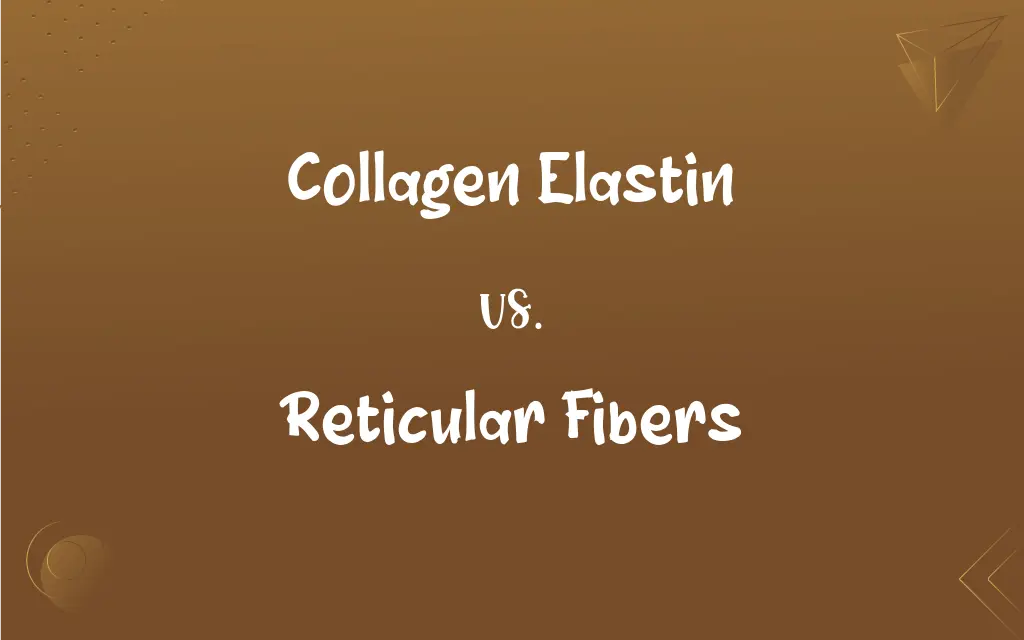Collagen Elastin vs. Reticular Fibers: What's the Difference?
Edited by Aimie Carlson || By Janet White || Published on December 24, 2023
Collagen and elastin are proteins providing structure and elasticity to skin and tissues, whereas reticular fibers form a supportive mesh in soft tissues.

Key Differences
Collagen and elastin are major structural proteins in the body, providing strength and flexibility to skin, bones, and connective tissues. Reticular fibers, composed of type III collagen, create a fine network supporting cells in various organs.
Collagen provides tensile strength, preventing tissues from tearing under stress, while elastin allows tissues to stretch and return to their original shape. Reticular fibers, being finer, form a supportive mesh that holds cells and tissues together.
The abundance of collagen and elastin decreases with age, leading to wrinkles and less elastic skin. Reticular fibers, important in organs like the liver and lymph nodes, remain crucial for organ structure throughout life.
Collagen and elastin are targeted in cosmetic treatments for their role in skin health and appearance. Reticular fibers, while not a focus in cosmetics, are vital in pathological examinations for organ diseases.
Injuries to collagen and elastin can lead to stretch marks and scars. Damage to reticular fibers is often seen in diseases affecting soft tissues and organs.
ADVERTISEMENT
Comparison Chart
Composition
Collagen provides strength, elastin provides elasticity.
Type III collagen forms delicate networks.
Function
Support skin and tissue structure, allow flexibility.
Form a framework supporting cells in organs.
Location
Found throughout the body, especially in skin and tendons.
Located in soft tissues like liver, spleen, and lymph nodes.
Age-Related Changes
Decrease with age, affecting skin elasticity.
Remain relatively constant, but can be affected by diseases.
Role in Health and Disease
Affect skin aging, wound healing.
Important in the structure and function of soft organs.
ADVERTISEMENT
Collagen Elastin and Reticular Fibers Definitions
Collagen Elastin
Essential for wound healing and tissue repair.
Collagen and elastin play a crucial role in healing skin injuries.
Reticular Fibers
Supportive mesh in soft tissues like lymph nodes and spleen.
The structure of lymph nodes is maintained by reticular fibers.
Collagen Elastin
Decrease in these proteins contributes to signs of aging.
Cosmetic products often target collagen and elastin to reduce aging signs.
Reticular Fibers
Play a role in filtering and removing cellular debris.
In the spleen, reticular fibers help in filtering blood.
Collagen Elastin
Collagen provides rigidity, while elastin allows flexibility.
The elasticity of our skin is due to the balance of collagen and elastin.
Reticular Fibers
Fine, type III collagen fibers forming networks in organs.
Reticular fibers provide a scaffold for cells in the liver.
Collagen Elastin
Key proteins in connective tissues for strength and elasticity.
Collagen and elastin keep our skin firm and supple.
Reticular Fibers
Essential for organ structure and function.
Reticular fibers ensure the proper organization of cells in soft organs.
Collagen Elastin
Vital for the structural integrity of skin, tendons, and ligaments.
Aging affects the collagen and elastin in our skin, leading to wrinkles.
Reticular Fibers
Important in pathology for identifying organ damage.
Changes in reticular fibers can indicate liver diseases.
FAQs
What are reticular fibers made of?
Reticular fibers are made of type III collagen.
Are reticular fibers visible under a microscope?
Yes, they can be seen in histological samples with special staining.
What is the main function of collagen?
Collagen provides strength and structure to skin and connective tissues.
How do elastin and collagen differ?
Elastin allows tissues to stretch, while collagen provides rigidity and strength.
Where are reticular fibers found?
They are found in soft tissues like the liver, spleen, and lymph nodes.
What is the role of reticular fibers in organs?
They form a supportive mesh that maintains organ structure and function.
Does aging affect collagen and elastin?
Yes, their production decreases with age, leading to wrinkles and less elastic skin.
What causes collagen and elastin to degrade?
Aging, sun exposure, and lifestyle factors can contribute to their degradation.
Are reticular fibers important in immunity?
Yes, they play a role in the structure and function of immune organs.
Can diet affect collagen and elastin production?
A healthy diet with certain nutrients can support their production.
Do reticular fibers change during organ diseases?
Yes, changes in these fibers can indicate diseases like liver cirrhosis.
Are collagen and elastin supplements effective?
The effectiveness varies and is a topic of ongoing research.
Can collagen and elastin be replenished?
Certain treatments and skincare products claim to boost their production.
Do collagen and elastin aid in wound healing?
Yes, they are crucial for tissue repair and wound healing.
What role do reticular fibers play in filtration?
In organs like the spleen, they help in filtering blood and removing debris.
How do diseases affect reticular fibers?
Diseases can alter their structure, affecting the function of organs.
Is sun exposure harmful to collagen and elastin?
Yes, UV radiation can break down these proteins, leading to skin damage.
How are collagen and elastin used in cosmetics?
They are targeted in products aiming to improve skin elasticity and reduce wrinkles.
What techniques are used to study reticular fibers?
Histological staining and microscopy are commonly used.
Can reticular fibers regenerate?
Their regeneration depends on the health and condition of the organ.
About Author
Written by
Janet WhiteJanet White has been an esteemed writer and blogger for Difference Wiki. Holding a Master's degree in Science and Medical Journalism from the prestigious Boston University, she has consistently demonstrated her expertise and passion for her field. When she's not immersed in her work, Janet relishes her time exercising, delving into a good book, and cherishing moments with friends and family.
Edited by
Aimie CarlsonAimie Carlson, holding a master's degree in English literature, is a fervent English language enthusiast. She lends her writing talents to Difference Wiki, a prominent website that specializes in comparisons, offering readers insightful analyses that both captivate and inform.































































